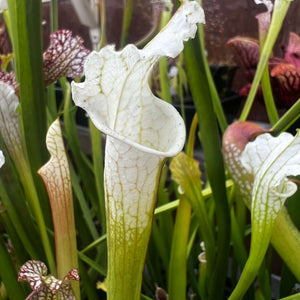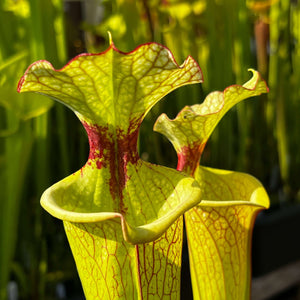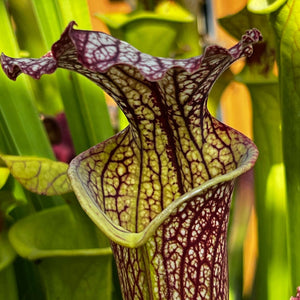Description of Iris pseudacorus 'Variegata'
Iris pseudacorus 'Variegata' brings a fresh look to the classic yellow flag iris. Gardeners often know it as the Variegated Yellow Flag. This plant combines cheerful yellow flowers with foliage that adds interest for many months.
Appearance and Key Features
This iris forms upright clumps. It typically reaches between 60 and 90 centimetres in height. The leaves are long and sword-shaped. They are the main attraction. Each green leaf has clear, creamy-yellow stripes running along its length. This pattern lasts from spring until autumn.
The flowers appear from late May into June. They are a bright, sunny yellow. Each bloom has three petals that stand up and three that curve downwards. These yellow flowers stand out well against the variegated leaves. Bees and other pollinators visit the flowers regularly.
Ideal Growing Conditions
Iris pseudacorus 'Variegata' performs best in a sunny spot. It can also handle partial shade. The crucial factor is moisture. This plant needs consistently wet soil to thrive.
It is perfect for the edges of a garden pond. You can also plant it in a bog garden or directly into shallow water. It can grow in water up to about 25 centimetres deep. Its roots help to stabilise the soil at the water's edge.
Planting and Ongoing Care
Plant the rhizomes so their tops are just visible at the soil surface. If planting in water, use aquatic planting baskets to help manage its spread. This iris is fully hardy throughout the UK. It will survive winter frosts without any trouble.
The plant grows from thick stems called rhizomes. These rhizomes spread out over time. To keep the plant healthy and prevent it from taking over a small space, divide the clumps every few years. The best time for division is after flowering in late summer. You can also do it in early spring.
Use a sharp spade to cut the rhizomes into sections. Replant the healthy pieces. This process gives you new plants to expand your garden or share with friends. Removing the old flower stems after blooming keeps the plant looking neat.
Garden Uses and Benefits
This iris works well as a focal point near water. Plant it where the sun can highlight its striped leaves. It combines effectively with other moisture-loving plants like marsh marigolds and water forget-me-nots.
Beyond its good looks, Iris pseudacorus 'Variegata' supports garden wildlife. The flowers provide nectar for bees and butterflies. The dense clumps offer shelter for frogs and other small creatures. The roots help to filter water and reduce bank erosion in ponds.
An Important Consideration
This is a vigorous plant. In the right conditions, it can spread quite quickly. While this is useful for filling a space, it needs to be managed in a smaller pond or garden. Regular division, as mentioned above, is the best way to control its size. Be mindful that the standard yellow flag iris can be invasive in some wild wetland areas. Always compost your garden waste responsibly.
Iris pseudacorus 'Variegata' is a practical choice for adding colour and structure to damp areas. Its variegated leaves ensure it remains attractive long after the yellow flowers have faded.

 UK-grown carnivorous plants
UK-grown carnivorous plants




